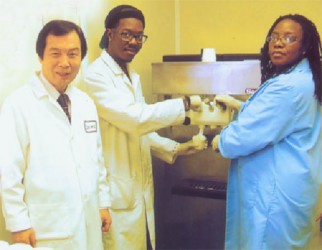Evaluation of nutritional, chemical, textural and sensory characteristics of goat milk ice cream manufactured with three different levels of Caprine milk fat
New research has been launched at Fort Valley State University for development of goat milk ice cream and its quality evaluation. At the university’s Georgia Small Ruminant Research and Extension Center, this study was initiated and conducted by Dr. Young Park, professor of food science, and his graduate student, Christopher McGhee. The student has been working on his master’s thesis project in collaboration with Park’s dairy technology research group.
The dairy goat industry, especially the goat milk ice cream enterprise, has not been developed in the U.S. On the other hand, 9 percent of total milk production in the U.S. has been used for production of ice cream, which is an important part of the economic condition of the U.S. dairy industry (USDA, 2011). The frozen dessert market is predominantly the ice cream market. In 2009, the ice cream market amounted to 1.52 billion gallons (5.75 billion liters), which comprised 86.7 percent of the total volume of all frozen desserts in the U.S. (USDA, 2011).
In general, ice cream has been a highly popular frozen dairy food around the world. Although numerous studies have been conducted on the nutritional, chemical, rheological and sensory characteristics of cow milk ice cream, such studies on goat milk ice cream have been almost nonexistent. Therefore, this research project was focused on: (1) determining nutritional values of goat milk ice creams formulated with three low levels of goat milk fat; (2) evaluating textural and sensory characteristics of the goat ice creams with respect to consumer acceptability during eight weeks of frozen storage (-20°C); and, (3) comparing the differences in storage stability with respect to changes in lipolysis and fatty acid compositions of the three formulated goat milk ice creams during the frozen-storage periods.
In the first study, rheological and textural characteristics of the caprine ice creams were compared among the three different products manufactured with three levels of goat milk fat. Three batches of three different low-fat goat milk ice creams were manufactured using a commercial ice cream mix (0.25 percent fat; Alpha Freezz, Tampa, Fla.,) formulated with three levels of milk fat as skim (0.46 percent; SIC), 2 percent (2IC) and whole (3.65 percent; WIC) goat milk. The fresh soft serve ice creams were made using the SaniServ ice cream maker (A5223P, Mooresville, Ind.), and stored for zero, one and 90 days at 18 degrees C in a freezer. Textural characteristics of all experimental caprine ice creams were evaluated for firmness, consistency, cohesiveness and index of viscosity using a texture analyzer (Model TA.XT21, Texture Technology Corp., Scarsdale, NY). Viscosity of the ice creams was measured by firmness (g force) and consistency, and adhesiveness of stickiness was measured by cohesiveness (g force) and index of viscosity.

Average firmness values of fresh, one and 90-day frozen samples of SIC, @1C and WIC ice creams were 183.5, 717.4, 1051; 208.7, 852.7, 1403; 182.8, 559.6, 2072, respectively, indicating there were substantial (P<0.01) increases in firmness from fresh to one-day frozen samples of all three types goat ice cream. The increases in firmness, from one-day to 90 days, were much greater with high variations, suggesting that the three months of frozen product further hardened the texture compared to the one-day frozen ones. For the soft-serve fresh ice creams, firmness and consistency of WIC were higher than 21C and SIC, while the opposite trend was observed in cohesiveness of the three products. It was found that all tested textural properties were elevated in the caprine milk ice creams after the frozen storages, regardless of fat levels.
The second experiment was conducted to ascertain the possible lipolysis in the goat milk ice creams formulated as the first study with three different levels of caprine milk fat. The fresh soft-serve ice creams were stored for zero, two, four and eight weeks at – 18 degrees Celsius in a freezer. The acid degree values (ADV) of all the experimental ice creams were determined as the primary index of lipolysis, in addition to total fat assays of all ice cream samples using the Babcock fat test.
The results showed that the pooled, overall mean ADVs across all three batches of skim, 2 per cent and whole milk ice cream for zero, two, four and eight weeks storage were: 0.528, 0.291, 0.393; 0.499, 0.380, 0.423; 0.568, 0.371, 0.390; 0.691, 0.327, 0.401, respectively, indicating that skim goat milk ice cream revealed the highest ADV values among the three types of caprine ice cream products during the eight weeks of frozen storage. The two per cent fat goat ice cream had the lowest lipolytic changes compared to the skim and whole milk counterparts. Even though the differences in ADVs between the four storage periods were not significant and consistent, it was concluded that there was a trend of slight elevation in lipolytic values for all three types of the caprine milk creams, as the frozen-storage time advanced.





